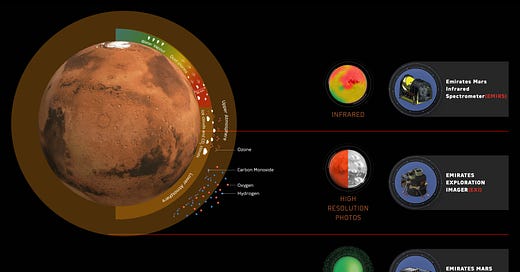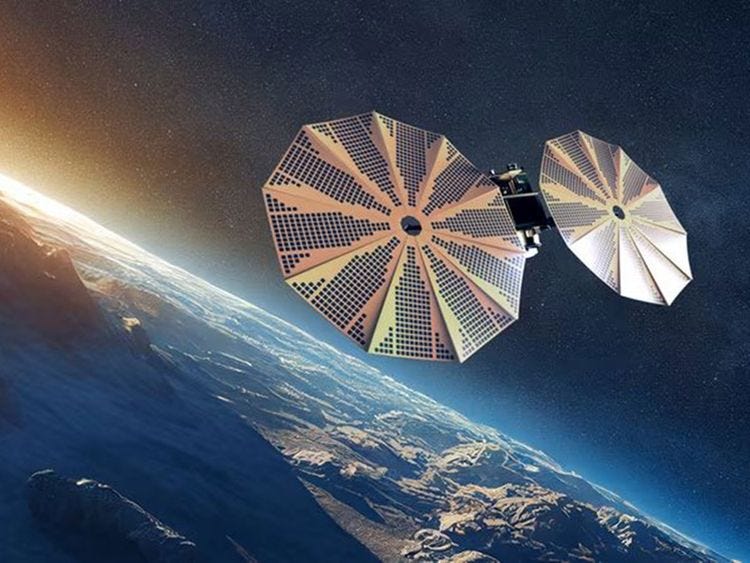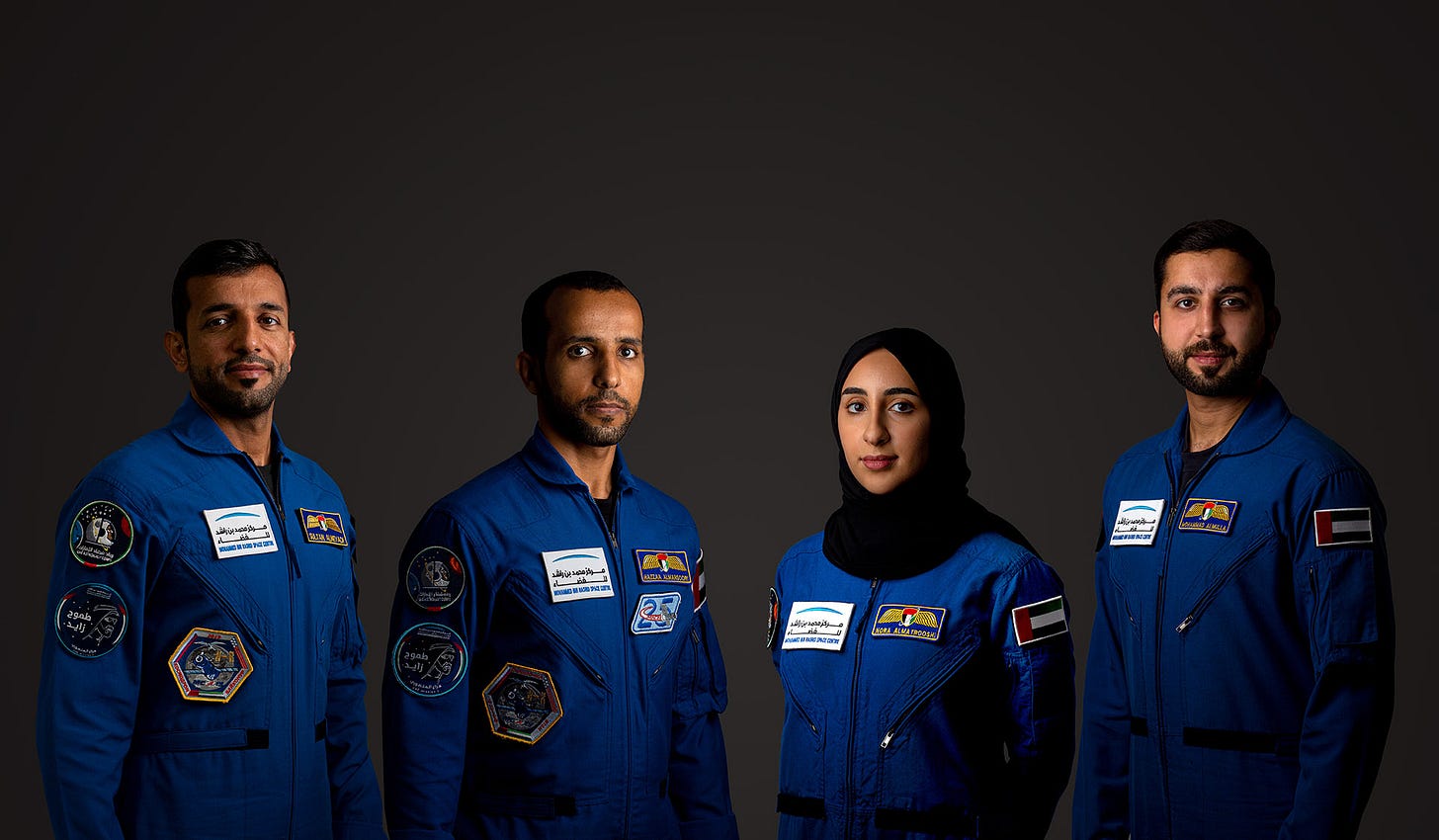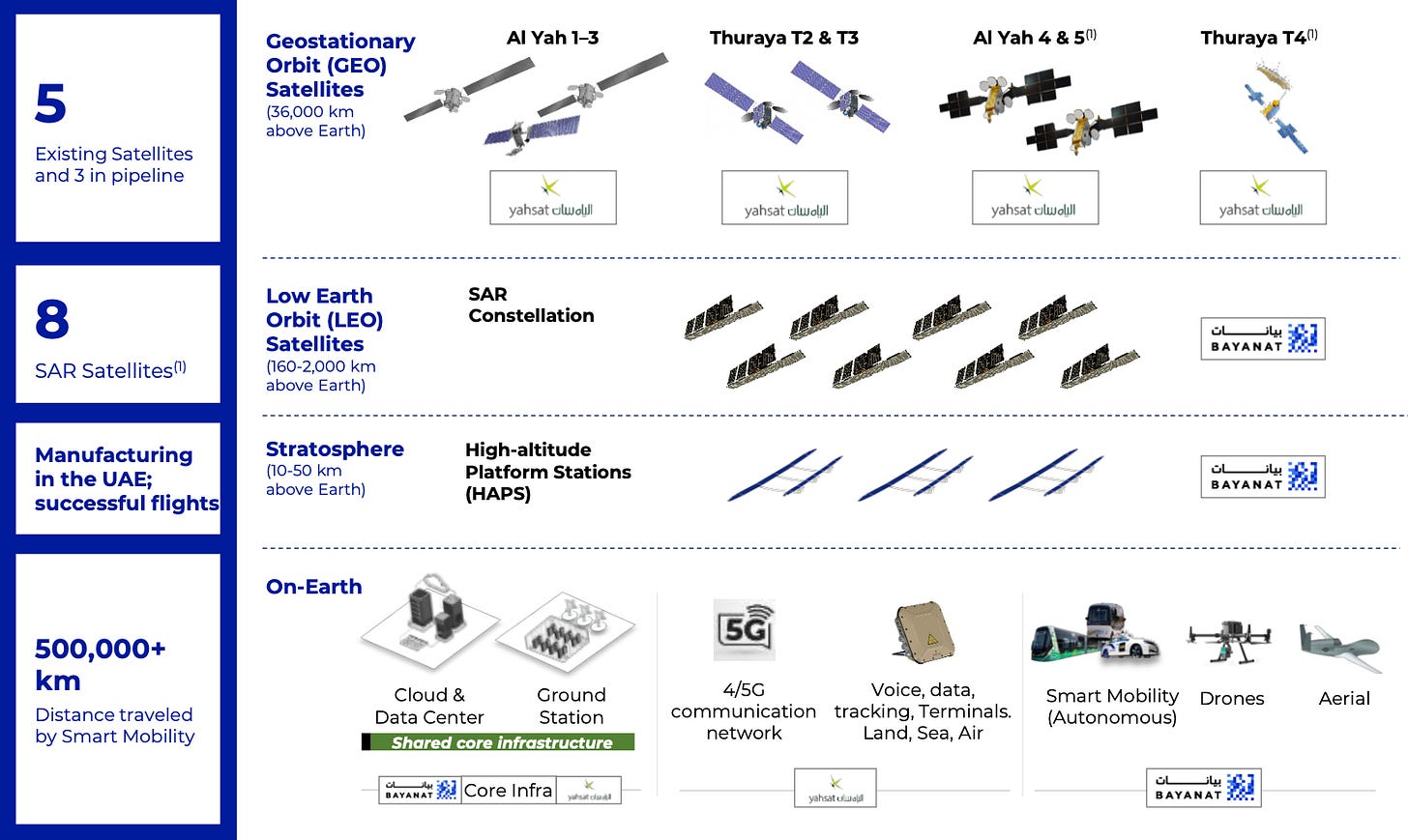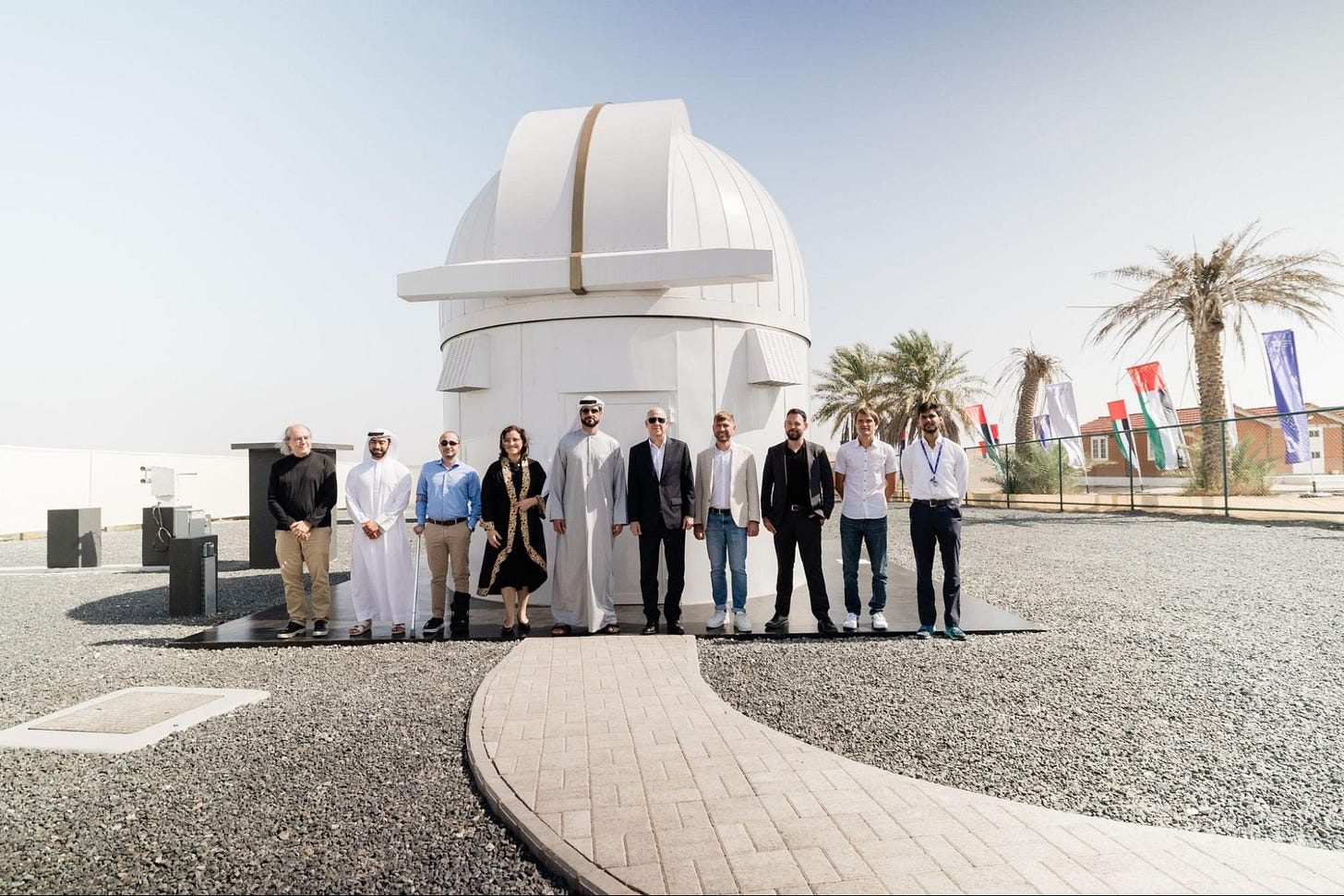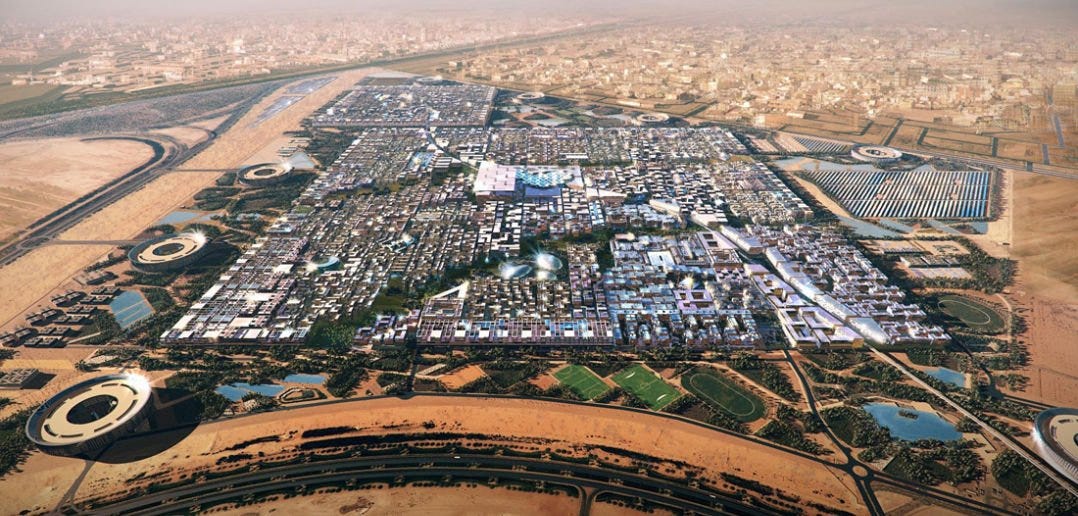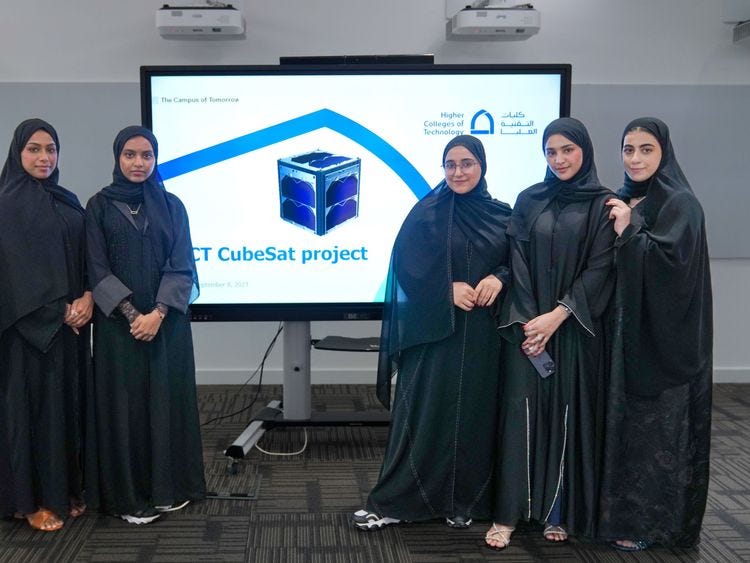Stars of the Desert: UAE's Pioneering Role in Space Exploration
Explore UAE's missions, space economic zones, ambitions for asteroid mining, lunar program, and education initiatives.
Issue 85. Subscribers 11 363.
We invite you to join the first professional investment community on AngelList focused exclusively on space tech investments: Beyond Earth Technologies
We teamed up with Viktor Shpakovsky, who is UAE resident, to share recent space tech developments in the country. He was one of our first readers and supporters, so we are absolutely thrilled to publish his piece in the blog.
The United Arab Emirates (UAE) has a long-standing interest in astronomy and space sciences, initiated in the 1970s by His Highness Sheikh Zayed bin Sultan Al Nahyan's meeting with the NASA Apollo moon landing team. This pivotal encounter ignited a national focus on space, leading to the establishment of the UAE's space sector. Key milestones include the founding of Thuraya Communications (Mobile Satellite Communication Company) in 1997 and Yahsat (Satellite Communications Company) in 2007, the launch of the Emirates Institution for Advanced Science and Technology in 2006 (in 2015 was merged with the Mohammed bin Rashid Space Centre (MBRSC), and the creation of the UAE Space Agency in 2014.
Recently The United Arab Emirates has emerged as a significant player in global space exploration, showcasing an ambitious vision. This article explores the UAE's journey from its initial steps in space science to its remarkable achievements, including the successful Mars mission, the Hope Probe. It explores the strategic initiatives, technological advancements, and international collaborations that underpin the nation's space ambitions. By examining the UAE's commitment to fostering innovation and inspiring future generations, this article highlights how the nation is not only reaching for the stars but also shaping a new era of space exploration in the Middle East.
The Emirates Mars Mission (EMM) - Hope Probe
The Emirates Mars Mission (EMM), known as the "Hope Probe", is the UAE's first mission to Mars built in partnership with the University of Colorado, Arizona State University, and the University of California. Designed to orbit the Red Planet, EMM aims to study the Martian atmosphere on a global scale, capturing both daily and seasonal variations. Using three advanced scientific instruments, the mission seeks to enhance our understanding of the dynamics within Mars' lower and middle atmosphere and to investigate the upward transport of energy and particles and their escape from Mars' gravity.
The mission aligns with the goals of the Mars Exploration Program Advisory Group (MEPAG), particularly in understanding the processes and history of climate on Mars. EMM's scientific investigations are crucial for characterizing the present-day climate of Mars.
To achieve its objectives, the Hope Probe is equipped with three instruments: EMIRS, an infrared spectrometer for analyzing the energy balance in Mars' climate; EXI, a high-resolution camera for capturing detailed images; and EMUS, an ultraviolet spectrometer for studying atmospheric variability. These instruments work together to provide a comprehensive picture of the Martian atmosphere.
EMM aims to explain how weather patterns influence the escape of hydrogen and oxygen, shedding light on why Mars is losing these elements into space. The mission's data will help identify the sources and sinks of energy in the Martian atmosphere, contributing to a better understanding of Mars' climate and weather systems.
There are numerous articles detailing the data collected by the mission. There is also a Science Data Center, the repository for all scientific data from the Emirates Mars Mission spacecraft.
New York University Abu Dhabi (NYUAD) group leader and research scientist Dimitra Atri from the Center for Space Science and his team have created a never-seen-before map of Mars, using images exclusively created from the Emirates Exploration Imager (EXI).
UAE Invites Private Companies for Ambitious Asteroid Mission
The UAE Space Agency has announced an Asteroid Mission that invites collaboration with local private companies, marking a significant milestone in the country's increased space exploration efforts. They provided an overview of this upcoming mission, detailing the areas to be managed by governmental entities and those open for tender to private companies.
The mission, comparable in scale to the Hope Mars Mission with a payload weight between 2000-2800 kg, is scheduled for launch in 2028. The agency is also welcoming research and university payloads to be integrated into the mission bus.
The key objectives include understanding the primordial materials that contributed to the formation of planets and exploring future endeavors like asteroid resource extraction, with the belt estimated to contain minerals worth $700 Quintillion. Additionally, the mission aims to investigate water-rich asteroids to learn about the origins and distribution of water in the solar system, and to study the composition of asteroids to gain insights into the origins and distribution of organic compounds, which are fundamental building blocks of life.
Khalifa University is one of the confirmed partners, contributing to the development of payloads in collaboration with the Italian Space Agency (check out our article about Italy’s SpaceTech ecosystem) . This partnership highlights the mission's emphasis on international cooperation and academic involvement. Two notable local companies, Sadeem (specializing in engineering services) and 971Space (focused on the control and management of spacecraft operations), have already secured participation in the mission.
The mission will be equipped with cutting-edge instruments, including a mid-wavelength infrared spectrometer from the Italian Space Agency (ASI), a high-resolution camera and thermal infrared camera from Malin Space Science Systems, and a thermal infrared spectrometer from Arizona State University and Northern Arizona University, based on the EMIRS instrument developed for the Emirates Mars Mission.
If you are interested in participating in the mission you should become a part of the Space Economic Zones Program and propose your ideas to Hosam Moustafa at h.moustafa@space.gov.ae. The main interest right now is in Mechanical Parts and the full list of the needed equipment will be available online soon.
The UAE Astronaut Programme
The UAE Astronaut Programme represents a significant leap for the United Arab Emirates in the area of space exploration. Aiming to cultivate a national team of astronauts, the program seeks to achieve the country’s scientific ambitions, participate in manned space missions, and contribute to global space exploration efforts.
One of the standout achievements of the UAE Astronaut Programme is the historic mission of Sultan Al Neyadi. His six-month stay aboard the International Space Station (ISS) from March 3, 2023, to September 4, 2023, as part of the SpaceX Crew-6 mission was marked as the longest space mission in Arab history. During this mission, Al Neyadi made history as the first Arab astronaut to conduct a spacewalk, thus positioning the UAE as the 10th country to perform such a feat on the ISS. This milestone not only elevated the UAE's status in space exploration but also inspired the broader Arab world.
The program, managed by the Mohammed bin Rashid Space Centre (MBRSC), has successfully developed a cadre of skilled astronauts. Alongside Al Neyadi, Hazza Al Mansouri, who was the first Emirati to travel to space, Noura Al Matrooshi, and Muhammad Al Mulla are key figures in this initiative. Al Matrooshi and Al Mulla have completed rigorous training at NASA’s Johnson Space Centre, gearing up for future missions.
UAE's Renewed Lunar Ambitions
The Mohammed bin Rashid Space Centre (MBRSC) is actively seeking a reliable landing vehicle for its upcoming lunar mission, aiming to safely transport the Rashid 2 rover to the Moon's surface. This comes after the unfortunate crash-landing of the first Rashid rover during the UAE's inaugural lunar mission last year.
The initial Rashid rover was launched aboard the Hakuto-r Mission 1 lander, developed by the Japanese company ispace. A software malfunction caused the lander to miscalculate its altitude and run out of fuel moments before landing. Despite this setback, the mission provided valuable data and insights for the MBRSC team. Adnan Al Rais, one of the assistant directors general at MBRSC, emphasized the importance of these lessons and how they helped in advancing technologies for the Rashid 2 mission.
MBRSC is exploring various options for a reliable lunar lander, monitoring the progress of space agencies and private companies. The team plans to complete the feasibility study by mid-year to determine the potential landing site for Rashid 2.
Successfully landing on the Moon remains a significant challenge, with only a few countries having achieved this feat. MBRSC had previously signed an agreement with China's space agency to send Rashid 2 aboard its Chang'e-7 mission in 2026. However, this agreement is no longer valid due to US International Traffic in Arms Regulations (ITAR) restrictions, as the rover contains US-built components.
The MBRSC team, which has grown since the Rashid 1 mission, is focused on advancing their technologies and exploring new lunar regions. Details of the Rashid 2 mission, including the landing attempt and site, will be announced soon by MBRSC.
Artemis Accords - Emirates Airlock
In January 2024, the Mohammed Bin Rashid Space Centre (MBRSC) and NASA announced that the UAE will provide a crew and science airlock module, named the “Emirates Airlock,” for NASA's new lunar “Gateway” space station, humanity's first international outpost to orbit the Moon.
The Emirates Airlock will enable astronauts to enter and exit the space station, conduct groundbreaking scientific research in deep space, and perform maintenance on Gateway.
This space station will be a pivotal platform for NASA’s planned Artemis missions, developing the technology and capabilities necessary for future Moon and Mars exploration. Additionally, a UAE astronaut is expected to participate in a future Artemis mission to Gateway.
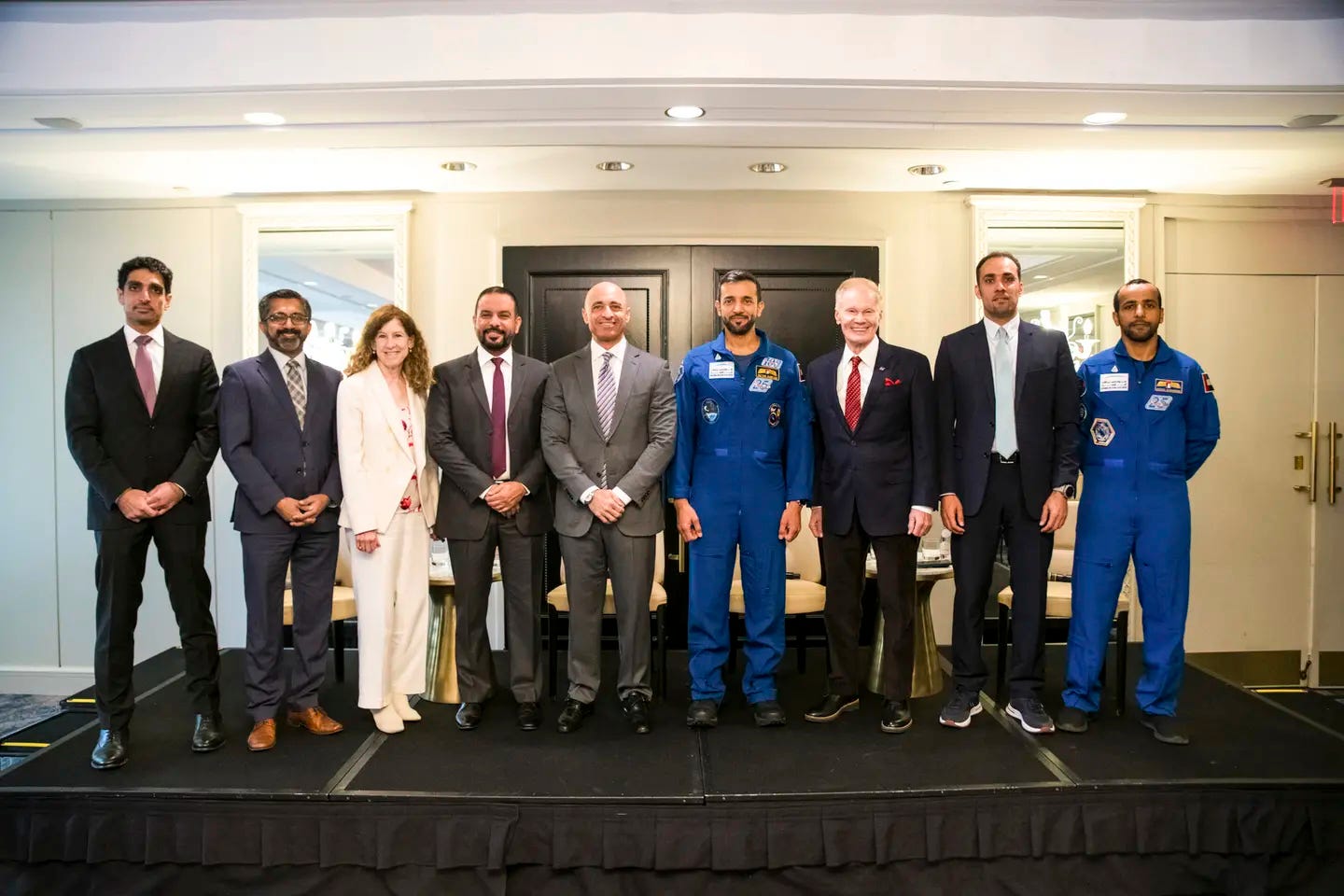
“We are in a new era of exploration through Artemis – strengthened by the peaceful and international exploration of space. The UAE’s provision of the airlock to Gateway will allow astronauts to conduct groundbreaking science in deep space and prepare to one day send humanity to Mars.” — NASA Administrator Bill Nelson
Bayanat-Yahsat Significant Merger into Space42
UAE space companies Bayanat and Yahsat have received shareholder approval for their merger, forming Space42, an AI-powered space technology leader. This merger, initially proposed in December 2023, aims to enhance the UAE's position in the space sector by combining advanced geospatial AI capabilities with satellite communications expertise. Yahsat provides multi-mission satellite services in over 150 countries, while Bayanat is a leader in geospatial analytics and technology innovation.
With combined revenue of AED 2.8 billion ($760 million) and net income of AED 639 million ($174 million), Space42 aims to provide increased value to stakeholders through synergies and sustained business growth.
Space42 will unlock value by uniting satellite communications (SatCom) and geospatial assets. The new entity will integrate sovereign orbital and ground architecture, providing security and control across data acquisition, transmission, and analytics, offering near-real-time geospatial and communications capabilities. It will feature common operations and management for both SatCom and geospatial services, unlocking cost synergies and providing a single interface with satellite manufacturers. Consolidated manufacturing capabilities will also allow for possible vertical expansion.
AI will play a significant role in Space42, impacting network optimization and management, signal processing, interference mitigation, predictive maintenance, and enhanced security. This will lead to adaptive and resilient communication systems.
Ali Al Hashemi, CEO of the Yahsat Group, highlighted the transformative impact of the merger, emphasizing Space42's emergence as a global AI-powered entity specializing in space technology and geospatial solutions, with a market value of over AED 15 billion ($4 billion). The integration is expected to bolster revenues, fuel innovation, and pave the way for regional and international expansion.
State-of-the-Art Quantum Communication Facility
This facility, the Abu Dhabi Quantum Optical Ground Station (ADQOGS), is set to integrate Abu Dhabi and the wider UAE into the global Quantum Key Distribution (QKD) network, enhancing secure and private communication capabilities.
QKD, one of the most mature quantum communications technologies, uses quantum signals to establish encryption keys that are immune to tampering or interception. While existing optical fiber infrastructure supports metropolitan QKD networks for distances under 100 kilometers, significant signal loss in long-distance fiber connections makes global-scale fiber-based quantum networks impractical. Free-space optical transmission between satellites and ground-based receivers is currently the only viable solution for bridging international distances.
ADQOGS will ensure regional connectivity, serving as a master station for ultra-secure key material, future-proofing secure networking in the UAE. The facility underscores the Technology Innovation Institute's (TII) ability to collaborate with the global research community, building on partnerships such as its collaboration with the National University of Singapore's Centre for Quantum Technologies.
Located at Al Sadeem Observatory in Al Wathba, the 2,363sqm facility features a fully automated astronomical dome housing an 800mm diameter tracking telescope, a control room for operational oversight, and a sophisticated weather station for sky monitoring and scintillation estimations. A secondary platform is available to accommodate local and international portable optical ground stations, fostering collaboration in the sector.
At the core of the facility, ADQOGS is equipped with a versatile Quantum Acquisition and Tracking system designed at TII. The fully automated quantum receiver module detects quantum signals within the 760nm to 860nm wavelength range. Its unique optical system design ensures compatibility with a wide range of uplink and downlink beacons, supporting high-throughput optical modulation schemes ranging from 680nm to 1,600nm.
Space Economic Zones
The UAE Space Economic Zones Program, initiated by the UAE Space Agency, aims to foster the growth and innovation of space technology startups and SMEs. These Zones are located all over the UAE, providing an integrated business environment for space-related companies in sectors such as satellite communication, launch services, logistics, and data analysis.
This program offers customized business licenses, streamlined government services, and access to advanced space laboratories and research centers. It also includes an accelerator group to support startups with mentorship, technical assistance, and consultancy services. Competitive office spaces all over the UAE, further enhance the ecosystem's support for space enterprises.
The primary goals of the program are to boost the global competitiveness of UAE-based space companies, promote public-private partnerships, stimulate innovation, and support the economic contribution of the space sector to the UAE's non-oil GDP. By providing financial solutions, workspace, and promotional opportunities, the program aims to make the UAE a global hub for space technology, encouraging participation in both national and international space initiatives.
One interesting example of the residents of the Space Economic Zone is the Madari Space startup, whose founder Shareef Al Romaithi is participating in NASA's Human Exploration Research Analog Mission right now. Madari Space's solution involves creating space-based data centers, which are energy-efficient and offer enhanced security.
These centers leverage solar power and advanced technologies to minimize environmental impact while providing reliable and secure data storage and transmission services. The company submitted a proposal to Mohammed bin Rashid Space Center (MBRSC) for the Payload Hosting Initiative (PHI) that could launch their first prototype to space in 2025.
Another good example of a company based in the Space Economic Zone is Stellaria, which provides important data to the UAE Space Agency. Stellaria combines satellite imagery, physical models, weather forecast models, and AI to offer detailed analytics on methane and CO2 emissions. Their services include tracking methane concentration at various locations, monitoring its daily movement, and detecting small emissions (over 100 kg/h). This data is also crucial for oil companies to detect anomalies and manage emissions effectively, enhancing environmental monitoring and operational efficiency.
Nurturing the Next Generation of Space Experts
The National Space Academy aims to enhance young Emiratis’ expertise in space science and technology, adhering to the most rigorous international standards. By equipping these individuals with world-class knowledge and skills, the academy seeks to empower them to make significant contributions to the thriving success of the UAE Space Programme.
Students at the academy are exposed to training on key UAE projects, including the highly anticipated Asteroid Belt mission and the Bayanat data analytics platform. These projects are at the forefront of the UAE’s space exploration efforts, providing students with hands-on experience and a deep understanding of cutting-edge technologies and methodologies.
The academy welcomed its first batch of 51 students in January 2023. These pioneering students attended workshops that laid the foundation for their intensive training set for the first quarter of 2024. The subsequent phases saw 26 and 13 students enrolled, respectively, each cohort building on the success of the previous one.
Upon completing the workshops, graduates underwent a rigorous three-month space mission training. This comprehensive program covered various aspects of space missions, from theoretical knowledge to practical applications. The training ensured that graduates were well-versed in the complexities and challenges of space exploration.
Another educational activity worth mentioning is the UAE’s Mohammed Bin Rashid Space Centre (MBRSC) and the Higher Colleges of Technology (HCT) HCT-SAT-1 project. It is building HCT's first student-led space mission. Scheduled for launch by the end of 2024, the Earth-observation CubeSat is being developed by HCT students under the guidance of MBRSC engineers. This collaboration involves comprehensive knowledge transfer and mentorship across all satellite lifecycle phases, promoting space technology integration in education.
Thirty-four Emirati students, only nine of them male and the rest 25 female, supported by nine faculty members, are working on this interdisciplinary project. H.E. Salem Humaid Al Marri, Director General of MBRSC, highlights the project's role in fostering innovation and excellence among youth, aligning with UAE’s space exploration goals. Dr. Faisal Al Ayyan, President & CEO of HCT, emphasizes the strategic importance of space research in driving human progress and enhancing UAE’s global standing in space exploration.
We at Space Ambition are happy to see that more countries are involved in the aerospace sector and we hope that more will follow the UAE example. If you are a startup and you believe that you want to start your journey in the UAE, please shoot us an email via hello@spaceambition.org. We’d be happy to brainstorm ideas and share with you our insights. Let's push the boundaries of what's possible together and drive the future of space exploration!


